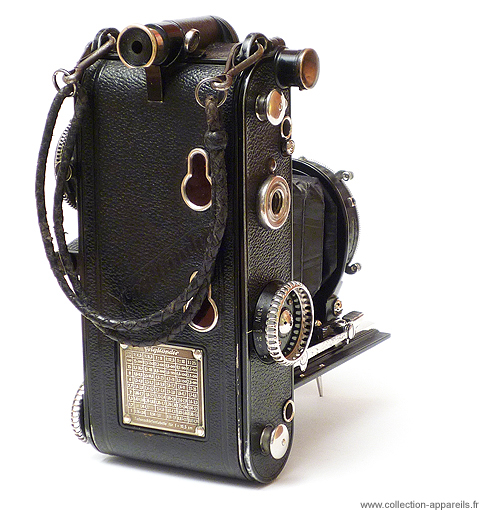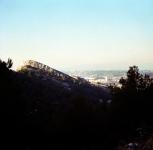|
Voigtlander Prominent |
Manufactured or assembled in Germany from 1932 to 1935.
Index of rarity in France: Rare (among non-specialized garage sales)
Inventory number: 21134
See the complete technical specifications
Chronology of cameras Voigtlander
Traduction de Manuel M
Here is a camera which does not leave indifferent!
By its form, first. Its appearance of hammerhead shark prevents from confusing it with other folding cameras.
By its characteristics, then, it had practically all that one could want on a folding camera:
Starting with a coupled rangefinder located at the top of the camera whose positioning of the two lateral prisms give it its recognizable appearance. Of very wide basis (90 mm), with coincidence of half-image whose half-circles are horizontal, the centring is very clear and thus the adjustment very easy. Nothing to do with a Leica of the same time. Moreover the eyepiece of centring is mounted a dioptric tube to adapt to the user sight.
The optical viewfinder is not integrated into the rangefinder but is located on the left side of the camera. It is provided with an hiding mask with hinges for the format 4.5 x 6.
One continues with the photographic exposure meter. With it all alone it is already a jewel. He will remind some flying saucers of films of the Fifties.
It is about a photographic exposure meter with extinction. It is composed of three revolving:
That of the top has three round windows for the various luminosities: light, medium or strong, as well as graduations of sensitivity expressed in Scheiner degrees. The directions for use give even conversion into Hurter & Driffield (H&D) degrees. This two scales not being of course more used nowadays, you will find the equivalents in Din/Asa here.
That of the middle is engraved of diaphragm values. It is question of positioning the red arrow opposite the Scheiner value of film.
This made, one looks in the eyepiece, and one turns the element of the bottom, engraved of speeds values, until the eye does not distinguish any more the visible hatchings.
There is nothing to do that reading the value of the couple speed/diaphragm thus determined. The directions for use indicate corrections to be made for the artificial light, the arc lamp or mercury and nitraphote lamp .
It is possible to make the focusing, prior to the opening of the camera thanks to a system of chain, as on the Perkeo and the Inos II of the brand.
The setting is automatic, a button is enough to open the camera and to unfold the bellows.
The serrated rollers of focusing and advance are openwork, just as those of the photographic exposure meter, for the aesthetic unity of the whole.
The opening of the back, on hinge and equipped with a table of depth of field, is done by gripping the two metallic parts in shape of ears of Mickey, located on both sides of the eyepiece of the rangefinder.
At the bottom of the back, is an mask for the format 4.5 x 6, to position between the 4 rivets located on the guide rail of film.
Let us profit to notice, in the housings of film, 4 baffles of escape of air which end outside the camera on the sides, intended to avoid the suction of film during the opening or the closing of the camera, like the Perkeo of the same brand.
The specimen presented preserved its typical belt out of braided leather.
It is equipped with the top-of-the-range lens of Voigtlander: an Heliar of 105 mm open to 4.5, an anastigmat with 5 lenses, and of a Compur shutter offering speeds from 1s to 1/250 second, pose B and T and self-timing.
The camera being supposed to be at the time, the “nec plus ultra”, therefore no concession: only one version,the best! No other alternative of shutter or lens was available.
There exists nevertheless, maybe, with some specimens, a version known as “Turbo” equipped with a Compur shutter with higher speed, the 1/400 second…
The Prominent was proposed with 1800 francs in 1933, i.e. say the price of a Leica II with its lens Elmar 3.5 which did not have however a photographic exposure meter. Just as Contax I which was proposed with 1990 francs with a Zeiss Tessar 3.5.
Its rather short career lasted from 1932 to 1935. It was replaced in 1936 by the Bessa RF (RF for RangeFinder), whose organs were less salient, but… which misses the photographic exposure meter.
Voigtlander started again the name Prominent for its 24 x 36 of 1950.
One dawn good beast! …



Interesting links or bibliography :
Add a link or element of bibliography, a picture taken with this camera, a picture of box or an ads about this camera
Your photos taken with the same camera:
Cameras from Ebay France (Voigtlander) (Uploaded each 3 hours)








